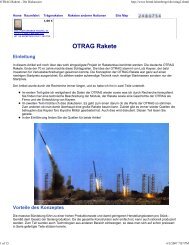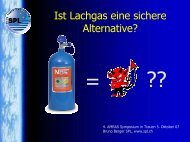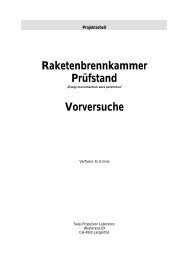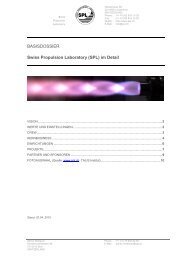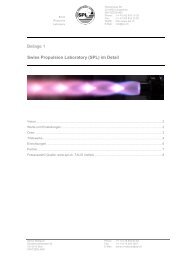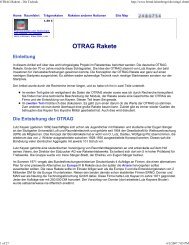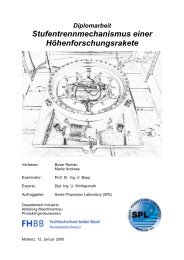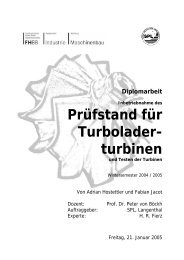You also want an ePaper? Increase the reach of your titles
YUMPU automatically turns print PDFs into web optimized ePapers that Google loves.
about 20 for uneconomic (This value is in modern Oberstufen 100-1000 utilize efficiently<br />
the fuel). He refers, however that the closely spaced engines produce a common<br />
collimated beam, which generates a dynamic pressure, which should offset this again to<br />
some extent.<br />
In the built form of the nozzle end almost directly behind the nozzle throat, so that the<br />
fuel was not used very efficiently. The area ratio of nozzle throat to nozzle outlet is only<br />
6<br />
Ignition takes place through a liquid (50% furfuryl alcohol in 50% water) at the bottom of<br />
the diesel oil tanks, the first flows into the engine. The 0.3 kg furfuryl alcohol in aqueous<br />
solution miscible heavy as diesel oil, and not with this. The mixture is hypergolic with<br />
HDA, thus igniting on contact. The ignition takes place within 10 ms and the inflow of<br />
diesel oil maintains the burn. A re-ignition is not possible and an ignition under<br />
microgravity not (in this case would Furanol with the fuel mix).<br />
Cross section through the engine is done via a control valve with a planetary gear that<br />
regulate the fuel flow in 3 positions. (Close, Half Flow, Full flow). The flow rate<br />
corresponded to half a thrust of 40% of the nominal value. The missile would likely be by<br />
lowering the flow on one side and so the thrust reduced. In the aerodynamic phase, tube<br />
fin in the simple first models (short pipes) rather than stabilize the rocket fins. This<br />
concept was tested in wind tunnels of DFVLR. Larger versions would be a system of<br />
thrust used to change the path.<br />
In addition to controlling the thrust of the inflow, it was also possible to regulate the<br />
thrust through the supply pressure. This decreased, while the tanks empty, on its own<br />
from 40 to 15 bar. It would also have been possible to reduce the initial pressure. The<br />
minimum shear for stable operation was 40% of the nominal thrust, or about 10 kN.<br />
Each engine contains a simple microcontroller, which can only determine whether an<br />
engine works. It was a simple ASIC from Motorola, which was cast with the nickel<br />
cadmium battery and two Darlington transistors in a polyurethane block. The Darlington<br />
transistors would allow the high current load for the motors to generate the supply<br />
voltages without the battery to charge.<br />
In case of malfunction, the valve is closed and passed a message to the host computer to<br />
control the entire missile by radio. This switches the case of malfunction the<br />
corresponding opposite engine to thrust is symmetrical. This control has been tested by<br />
computer simulations.<br />
Kayser is the reliability of the engines as the "6 Sigma". But it is a size from the<br />
production technology, the estimated production for a committee of 3.4 parts of 1 million<br />
units produced. There is no reliable value for rocket engines. Similarly designed engines<br />
for satellites without cooling and discharge are estimated with a reliability of 99.55%.<br />
This value appears likely in view of the false starts of at least two <strong>OTRAG</strong> missiles.



